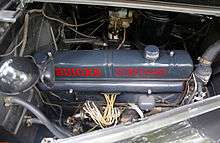Buick Straight-8 engine
The Buick Straight-8 engine (Fireball 8) was produced from 1931 to 1953 and sold in Buick automobiles, replacing the Buick Straight-6 engine across the board in all models in 1931. Like many American automobile makers, Buick adopted the straight-eight engine in 1931 as a more powerful alternative to the previous engines.
| Buick Straight 8 | |
|---|---|
| Overview | |
| Manufacturer | Buick |
| Also called |
|
| Production | 1931–1953 |
| Layout | |
| Configuration | Straight-8 |
| Displacement |
|
| Cylinder bore |
|
| Piston stroke |
|
| Valvetrain | OHV |
| Output | |
| Power output | 120–168 hp (89–125 kW) |
| Chronology | |
| Predecessor | Buick Straight-6 engine |
| Successor | Buick Nailhead V8 |
Design
Unlike most other car makers at the time, Buick had been using a valve-in-head/OHV overhead valve design or I-head since their inception and continued this practice in their straight-eight designs. The engine was sold in different displacements depending on the model of car and the year and was constructed upon two distinct (possibly more) block castings. The smaller displacement versions internally resembled the inline Chevrolet straight six, albeit with additional cylinders. The large block version (320 cid and 345 cid; used in large-chassis models such as the Roadmaster) was considerably heavier and this weight adversely affected vehicle performance and handling. In earlier years the engines used cast-in-place bearings that were then machined, which made engine rebuilding an expensive procedure, but after 1937 they began using drop-in bearings. The last year for Buick's straight-eight was 1953, but only in the lower-cost Buick Special. All other lines using the same basic chassis received the new V8 322 cu in (5.3 L) Nailhead. Starting in 1954, the Special received the V8 as well.
| Production | Engine | Displacement | Bore x Stroke |
|---|---|---|---|
| 1931 | 221 | 220.7 cu in (3.6 L) | 2.875 in × 4.25 in (73.0 mm × 108.0 mm) |
| 1931–1933 | 273 | 272.6 cu in (4.5 L) | 3.0625 in × 4.625 in (77.79 mm × 117.48 mm) |
| 1931–1935 | 345 | 344.7 cu in (5.6 L) | 3.3125 in × 5 in (84.14 mm × 127.00 mm) |
| 1932–1933 | 230 | 230.4 cu in (3.8 L) | 2.9375 in × 4.25 in (74.61 mm × 107.95 mm) |
| 1934–1935 | 235 | 235.4 cu in (3.9 L) | 2.9688 in × 4.25 in (75.41 mm × 107.95 mm) |
| 1934–1935 | 278 | 278.1 cu in (4.6 L) | 3.0938 in × 4.625 in (78.58 mm × 117.48 mm) |
| 1934–1936 | 233 | 233.0 cu in (3.8 L) | 3.0938 in × 3.875 in (78.58 mm × 98.43 mm) |
| 1936–1952 | 320 | 320.2 cu in (5.2 L) | 3.4375 in × 4.3125 in (87.31 mm × 109.54 mm) |
| 1937–1950 | 248 | 248.1 cu in (4.1 L) | 3.0938 in × 4.125 in (78.58 mm × 104.78 mm) |
| 1950–1953 | 263 | 263.3 cu in (4.3 L) | 3.1875 in × 4.125 in (80.96 mm × 104.78 mm) |
| source: Carnut.com[1] | |||

1952 Production Engines and Ratings
| Series | Engine | Displacement | Bore x Stroke | Power |
|---|---|---|---|---|
| 40 | 263 | 260.3 cu in (4.3 L) | 3 3⁄16 in × 4 1⁄8 in (81.0 mm × 104.8 mm) | 120 hp (89 kW) @ 3600 rpm |
| 50 | 124 hp (92 kW) @ 3600 rpm | |||
| 70 | 320 | 320.2 cu in (5.2 L) | 3 7⁄16 in × 4 5⁄16 in (87.3 mm × 109.5 mm) | 168 hp (125 kW) @ 3800 rpm |
| Note: The 320 has a head length of 34 1⁄2" while the smaller engines are 31 1⁄4" long. | ||||
| source: 1952 Buick service manual[2] | ||||
References
- "Car Specs". Carnut.com. Retrieved 2011-12-31.
- Cull, Robert. "Buick Straight Eight Specifications". Teambuick.com. Retrieved 2011-12-31.
External links